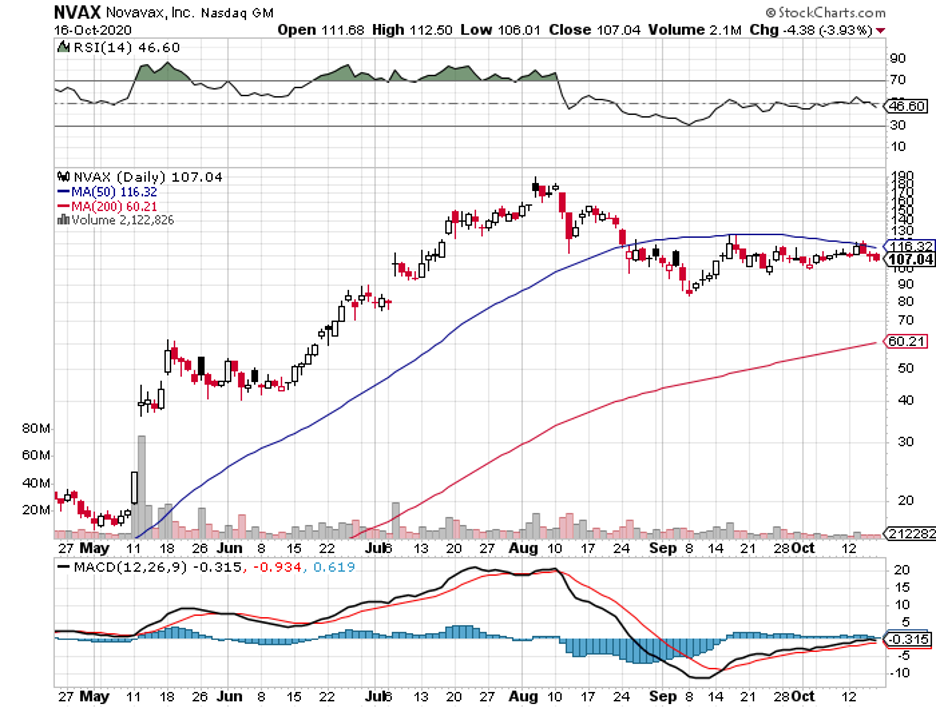It is not at all surprising that the biggest names in the healthcare industry are dominating the COVID-19 vaccine race.
After all, Big Pharmas such as Pfizer (PFE), AstraZeneca (AZN), Johnson & Johnson (JNJ), and Sanofi (SNY) are backed with vast resources that even media favorites like Moderna (MRNA) find challenging to compete against.
For months now though, going head to head with these big-name frontrunners is a clear outlier: Novavax (NVAX).
So far, there are only 10 COVID-19 vaccine candidates that have reached late-stage testing and Novavax’s NVX-CoV2373 has been performing at par (if not better) than its rivals—and the market has definitely noticed.
When 2020 started, Novavax’s market capitalization was less than $130 million and traded at roughly $4 per share.
Ten months into the pandemic, this small biotechnology company’s market cap grew to over $6.5 billion and has been trading at $110 per share—and that is already after a price decrease in the past weeks.
Given the disparity in its size and resources compared to its competitors, it’s safe to say that Novavax has been punching way above its weight class particularly in terms of landing supply agreements for its COVID-19 program.
Novavax first received a CEPI grant in March worth $4 million, which was immediately dwarfed by the $384 million the biotech company got in May.
In a matter of months, Novavax joined the major league players and secured a $1.6 billion funding courtesy of the US government’s Operation Warp Speed program.
In exchange, the biotech company will supply 100 million doses of NVX-CoV2373 to the US upon approval.
Novavax also inked an agreement with the UK for 60 million doses and another with Canada for 76 million doses.
Novavax has also landed deals with Japan through Takeda Pharmaceutical (TAK) and India via the Serum Institute of India.
As expected, the grants and supply agreements were perceived as votes of confidence on Novavax’s work and the company reaped the rewards.
In March, the prices started moving from less than $10 per share to almost $50.
By May, the price moved up to roughly $80 per share.
After its Operation Warp Speed contract in July, Novavax’s price per share soared all the way to $189 before eventually falling to $110 this October.
Novavax has only conducted late-stage testing in the UK. But, Phase 3 is expected to begin in the US soon as well.
Admittedly, a lot is riding on NVX-CoV2373.
However, the company has actually offloaded the majority—if not all—of its financial risks linked to the program.
Riding the momentum of its COVID-19 vaccine candidate, Novavax has been working on a related influenza vaccine called Nanoflu.
Given the market size for this, Nanoflu is estimated to rake in an annual revenue somewhere between $550 million and $1.7 billion.
Another potential blockbuster is respiratory syncytial virus (RSV) vaccine ResVax, which is projected to reach peak sales of $2 billion.
Novavax is also working on a vaccine candidate for the Ebola virus, the Middle East Respiratory Syndrome (MERS-CoV), and Severe Acute Respiratory Syndrome (SARS).
While NVX-CoV2373 is anticipated as Novavax’s moneymaker in the coming years, the biotech company can only realistically expect massive sales from this until 2023.
Looking at the company’s manufacturing partnerships and the aggressive timeline it has taken, Novavax is expected to produce 2 billion doses of its COVID-19 vaccine by mid-2021.
This is great news for its investors because of Novavax’s smaller market capitalization compared to its competitors.
Since the biotech company is projected as one of the first companies—if not the first—to offer a vaccine, then it can cover a substantial market share before its bigger rivals take over the market.
Even if Novavax prices its COVID-19 vaccine cheaply, say, $10 per dose, it can still generate $20 billion in annual sales.
Moreover, the late-stage success of NVX-CoV2373 will definitely cause Novavax’s stock price to skyrocket.
Despite this potential though, it’s important to keep in mind that this biotech company still has a way lower market cap than its rivals.
That means its share price will move a lot higher compared to the stocks of the other vaccine leaders.
Therefore, Novavax’s small size is not a negative for its investors—it is actually an advantage.
So for biotech investors who are searching for a promising COVID-19 vaccine stock, there’s nothing cheaper and more promising than Novavax.

